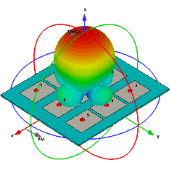udp画螺旋电感的例子
05-08
最近在做螺旋电感仿真,用udp生成电感,把例子里面的改动了一下,源代码贴上来给大家看看,
#include "../Headers/UserDefinedPrimitiveDLLInclude.h"
// User's own utility function prototypes
long CreatePath(struct UDPFunctionLib* functionLib, void* callbackData, double* paramValues, struct UDPPosition* startPt, struct UDPPosition* endPt);
long CreateProfile(struct UDPFunctionLib* functionLib, void* callbackData, double* paramValues);
void NameEntities(struct UDPFunctionLib* functionLib, void* callbackData, double* paramValues, struct UDPPosition* startPt, struct UDPPosition* endPt);
static struct UDPPrimitiveTypeInfo primitiveInfo =
{
"Rectangular Spiral",
"Create a Rectangular Spiral in XY plane",
"... Corporation",
"09-25-2006",
"1.0"
};
extern "C" DLLEXPORT
struct UDPPrimitiveTypeInfo* GetPrimitiveTypeInfo()
{
return &primitiveInfo;
}
struct UDPPrimitiveParameterDefinition primParams[] =
{
{"Xpos", "X Position of start point", kUDPLengthUnit, 0},
{"Ypos", "Y Position of start point", kUDPLengthUnit, 0},
{"Dist", "Distance between turns", kUDPLengthUnit, 5},
{"Turns", "Number of turns", kUDPNoUnit, 2},
{"Width", "Width of the spiral", kUDPLengthUnit, 2},
{"Thickness", "Thickness/height of the spiral", kUDPLengthUnit, 1},
{"Radius", "Radius of inner turn", kUDPLengthUnit, 10}
};
static int numOfParameters = sizeof(primParams)/sizeof(primParams[0]);
extern "C" DLLEXPORT
int GetPrimitiveParametersDefinition(struct UDPPrimitiveParameterDefinition** paramDefinition)
{
*paramDefinition = primParams;
return numOfParameters;
}
extern "C" DLLEXPORT
char* GetLengthParameterUnits()
{
return "mm";
}
char* registeredFaceNames[] = { "InnerEndFace", "OuterEndFace"};
static int numOfFaceNames = sizeof(registeredFaceNames)/sizeof(char*);
extern "C" DLLEXPORT
int GetRegisteredFaceNames(char*** faceNames)
{
*faceNames = registeredFaceNames;
return numOfFaceNames;
}
char* registeredEdgeNames[] = { "Inner-B", "Inner-L", "Inner-T", "Inner-R",
"Outer-B", "Outer-L", "Outer-T", "Outer-R"};
static int numOfEdgeNames = sizeof(registeredEdgeNames)/sizeof(char*);
extern "C" DLLEXPORT
int GetRegisteredEdgeNames(char*** edgeNames)
{
*edgeNames = registeredEdgeNames;
return numOfEdgeNames;
}
char* registeredVertexNames[] = { "Inner-B-L", "Inner-L-T", "Inner-T-R", "Inner-R-B",
"Outer-B-L", "Outer-L-T", "Outer-T-R", "Outer-R-B"};
static int numOfVertexNames = sizeof(registeredVertexNames)/sizeof(char*);
extern "C" DLLEXPORT
int GetRegisteredVertexNames(char*** vertexNames)
{
*vertexNames = registeredVertexNames;
return numOfVertexNames;
}
// Incase of error this function should return 0
extern "C" DLLEXPORT
int AreParameterValuesValid(char ** error, double* paramValues)
{
int noOfTurns = (int)paramValues[3];
double dist = paramValues[2];
double width = paramValues[4];
double height = paramValues[5];
double radius = paramValues[6];
// Number of turns cannot be < 1
if (noOfTurns < 1)
{
*error = "Number of turns cannot be less than 1.";
return 0;
}
// distance should be > 0
if (dist <= 0)
{
*error = "Distance should be more than 0.";
return 0;
}
// width should be > 0
if (width <= 0)
{
*error = "Width should be more than 0.";
return 0;
}
// height should be > 0
if (height <= 0)
{
*error = "Height/Thickness should be more than 0.";
return 0;
}
// distance between turns should be > width
if (dist <= width)
{
*error = "Distance between turns should be more than the width.";
return 0;
}
// radius should be > half width
if (radius <= width/2.)
{
*error = "Radius should be more than half width.";
return 0;
}
return 1;
}
extern "C" DLLEXPORT
long CreatePrimitive(struct UDPFunctionLib* functionLib, void* callbackData, double* paramValues)
{
struct UDPPosition startPt = {0,0,0};
struct UDPPosition endPt = {0,0,0};
long path = CreatePath(functionLib, callbackData, paramValues, &startPt, &endPt);
// Is path valid?
if (path == -1)
{
functionLib->addMessage(kUDPErrorMessage, "Could not create path", callbackData);
return 0;
}
// The profile
long profile = CreateProfile(functionLib, callbackData, paramValues);
// Is profile valid?
if (profile == -1)
{
functionLib->addMessage(kUDPErrorMessage, "Could not create profile", callbackData);
return 0;
}
struct UDPSweepOptions sweepOptions = {kUDPRoundDraft, 0.0, 0.0};
long success = functionLib->sweepAlongPath(profile, path, &sweepOptions, callbackData);
// Did the sweep operation succeed?
if (success == 0)
{
functionLib->addMessage(kUDPErrorMessage, "Could not sweep profile along path", callbackData);
return 0;
}
NameEntities(functionLib, callbackData, paramValues, &startPt, &endPt);
return success;
}
// User defined extra functions
long CreatePath(struct UDPFunctionLib* functionLib, void* callbackData, double* paramValues, struct UDPPosition* startPt, struct UDPPosition* endPt)
{
double xStart = paramValues[0];
double yStart = paramValues[1];
double CONST_Z = 0.0;
double dist = paramValues[2];
int noOfTurns = (int)paramValues[3];
double radius = paramValues[6];
int noOfPoints = 2 + 4*noOfTurns;
int noOfSegments = noOfPoints-1;
struct UDPPosition* arrayOfPositions = new UDPPosition[noOfPoints];
int i=0;
for (i=0; i<noOfPoints; i++)
arrayOfPositions.z = CONST_Z;
arrayOfPositions[0].x = xStart;
arrayOfPositions[noOfPoints-1].x = xStart;
double coord = 0.;
for (i=0; i<noOfTurns; i++)
{
int xs = i*4+1;
int ys = xs-1;
coord = radius+dist*i;
arrayOfPositions[xs].x = arrayOfPositions[xs+1].x = xStart-coord;
arrayOfPositions[xs+2].x = arrayOfPositions[xs+3].x = xStart+coord;
arrayOfPositions[ys].y = arrayOfPositions[ys+1].y = yStart-coord;
arrayOfPositions[ys+2].y = arrayOfPositions[ys+3].y = yStart+coord;
}
coord = radius+dist*i;
arrayOfPositions[noOfPoints-1].y = yStart-coord;
arrayOfPositions[noOfPoints-2].y = yStart-coord;
struct UDPPolylineSegmentDefinition* arrayOfSegmentDefinition = new UDPPolylineSegmentDefinition[noOfSegments];
for (i=0; i<noOfSegments; i++)
{
arrayOfSegmentDefinition.segmentType = kUDPLineSegment;
arrayOfSegmentDefinition.segmentStartIndex = i;
}
struct UDPPolylineDefinition polylineDefinition;
polylineDefinition.noOfPoints = noOfPoints;
polylineDefinition.arrayOfPosition = arrayOfPositions;
polylineDefinition.noOfSegments = noOfSegments;
polylineDefinition.arrayOfSegmentDefinition = arrayOfSegmentDefinition;
polylineDefinition.isCovered = 0;
long path = functionLib->createPolyline(&polylineDefinition, callbackData);
*startPt = arrayOfPositions[0];
*endPt = arrayOfPositions[noOfPoints-1];
delete[] arrayOfPositions;
delete[] arrayOfSegmentDefinition;
// Did the polyline operation failed?
//assert(path == -1);
return path;
}
long CreateProfile(struct UDPFunctionLib* functionLib, void* callbackData, double* paramValues)
{
double xStartPos = paramValues[0];
double yStartPos = paramValues[1]-paramValues[6];
double CONST_Z = 0.0;
double width = paramValues[4];
double height = paramValues[5];
int noOfPoints = 5;
int noOfSegments = noOfPoints-1;
struct UDPPosition* arrayOfProfPositions = new UDPPosition[noOfPoints];
arrayOfProfPositions[0].x = xStartPos;
arrayOfProfPositions[0].y = yStartPos-(width/2.0);
arrayOfProfPositions[0].z = -height/2.0;
arrayOfProfPositions[1].x = xStartPos;
arrayOfProfPositions[1].y = yStartPos+(width/2.0);
arrayOfProfPositions[1].z = -height/2.0;
arrayOfProfPositions[2].x = xStartPos;
arrayOfProfPositions[2].y = yStartPos+(width/2.0);
arrayOfProfPositions[2].z = height/2.0;
arrayOfProfPositions[3].x = xStartPos;
arrayOfProfPositions[3].y = yStartPos-(width/2.0);
arrayOfProfPositions[3].z = height/2.0;
arrayOfProfPositions[4].x = xStartPos;
arrayOfProfPositions[4].y = yStartPos-(width/2.0);
arrayOfProfPositions[4].z = -height/2.0;
struct UDPPolylineSegmentDefinition* arrayOfSegmentDefinition = new UDPPolylineSegmentDefinition[noOfSegments];
for (int i=0; i<noOfSegments; i++)
{
arrayOfSegmentDefinition.segmentType = kUDPLineSegment;
arrayOfSegmentDefinition.segmentStartIndex = i;
}
struct UDPPolylineDefinition polylineDefinition;
polylineDefinition.noOfPoints = noOfPoints;
polylineDefinition.arrayOfPosition = arrayOfProfPositions;
polylineDefinition.noOfSegments = noOfSegments;
polylineDefinition.arrayOfSegmentDefinition = arrayOfSegmentDefinition;
polylineDefinition.isCovered = 1;
long profile = functionLib->createPolyline(&polylineDefinition, callbackData);
delete[] arrayOfProfPositions;
delete[] arrayOfSegmentDefinition;
// Did the polyline operation failed?
//assert(profile == -1);
return profile;
}
void NameEntities(struct UDPFunctionLib* functionLib, void* callbackData, double* paramValues, struct UDPPosition* startPt, struct UDPPosition* endPt)
{
// Name faces
functionLib->nameAFace(startPt, registeredFaceNames[0], callbackData);
functionLib->nameAFace(endPt, registeredFaceNames[1], callbackData);
double width = paramValues[4];
double height = paramValues[5];
struct UDPPosition posOnEdge[8]; //numOfEdgeNames=8
// Inner face edges
// Inner face edge - Bottom
posOnEdge[0].x = (*startPt).x;
posOnEdge[0].y = (*startPt).y;
posOnEdge[0].z = (*startPt).z - height/2.0;
// Inner face edge - Left
posOnEdge[1].x = (*startPt).x;
posOnEdge[1].y = (*startPt).y - width/2.0;
posOnEdge[1].z = (*startPt).z;
// Inner face edge - Top
posOnEdge[2].x = (*startPt).x;
posOnEdge[2].y = (*startPt).y;
posOnEdge[2].z = (*startPt).z + height/2.0;
// Inner face edge - Right
posOnEdge[3].x = (*startPt).x;
posOnEdge[3].y = (*startPt).y + width/2.0;
posOnEdge[3].z = (*startPt).z;
// Outer face edges
// Outer face edge - Bottom
posOnEdge[4].x = (*endPt).x;
posOnEdge[4].y = (*endPt).y;
posOnEdge[4].z = (*endPt).z - height/2.0;
// Outer face edge - Left
posOnEdge[5].x = (*endPt).x;
posOnEdge[5].y = (*endPt).y - width/2.0;
posOnEdge[5].z = (*endPt).z;
// Outer face edge - Top
posOnEdge[6].x = (*endPt).x;
posOnEdge[6].y = (*endPt).y;
posOnEdge[6].z = (*endPt).z + height/2.0;
// Outer face edge - Right
posOnEdge[7].x = (*endPt).x;
posOnEdge[7].y = (*endPt).y + width/2.0;
posOnEdge[7].z = (*endPt).z;
struct UDPPosition posOnVertex[8]; //numOfVertexNames=8
// Inner face vertexs
// Inner face vertex - (common to Bottom & Left edge)
posOnVertex[0].x = (*startPt).x;
posOnVertex[0].y = (*startPt).y - width/2.0;
posOnVertex[0].z = (*startPt).z - height/2.0;
// Inner face vertex - (common to Left & Top edge)
posOnVertex[1].x = (*startPt).x;
posOnVertex[1].y = (*startPt).y - width/2.0;
posOnVertex[1].z = (*startPt).z + height/2.0;
// Inner face vertex - (common to Top & Right edge)
posOnVertex[2].x = (*startPt).x;
posOnVertex[2].y = (*startPt).y + width/2.0;
posOnVertex[2].z = (*startPt).z + height/2.0;
// Inner face vertex - (common to Right & Bottom edge)
posOnVertex[3].x = (*startPt).x;
posOnVertex[3].y = (*startPt).y + width/2.0;
posOnVertex[3].z = (*startPt).z - height/2.0;
// Outer face vertexs
// Outer face vertex - (common to Bottom & Left edge)
posOnVertex[4].x = (*endPt).x;
posOnVertex[4].y = (*endPt).y - width/2.0;
posOnVertex[4].z = (*endPt).z - height/2.0;
// Outer face vertex - (common to Left & Top edge)
posOnVertex[5].x = (*endPt).x;
posOnVertex[5].y = (*endPt).y - width/2.0;
posOnVertex[5].z = (*endPt).z + height/2.0;
// Outer face vertex - (common to Top & Right edge)
posOnVertex[6].x = (*endPt).x;
posOnVertex[6].y = (*endPt).y + width/2.0;
posOnVertex[6].z = (*endPt).z + height/2.0;
// Outer face vertex - (common to Right & Bottom edge)
posOnVertex[7].x = (*endPt).x;
posOnVertex[7].y = (*endPt).y + width/2.0;
posOnVertex[7].z = (*endPt).z - height/2.0;
for (int i=0; i<8; i++)
{
functionLib->nameAEdge(&(posOnEdge), registeredEdgeNames, callbackData);
functionLib->nameAVertex(&(posOnVertex), registeredVertexNames, callbackData);
}
}
#include "../Headers/UserDefinedPrimitiveDLLInclude.h"
// User's own utility function prototypes
long CreatePath(struct UDPFunctionLib* functionLib, void* callbackData, double* paramValues, struct UDPPosition* startPt, struct UDPPosition* endPt);
long CreateProfile(struct UDPFunctionLib* functionLib, void* callbackData, double* paramValues);
void NameEntities(struct UDPFunctionLib* functionLib, void* callbackData, double* paramValues, struct UDPPosition* startPt, struct UDPPosition* endPt);
static struct UDPPrimitiveTypeInfo primitiveInfo =
{
"Rectangular Spiral",
"Create a Rectangular Spiral in XY plane",
"... Corporation",
"09-25-2006",
"1.0"
};
extern "C" DLLEXPORT
struct UDPPrimitiveTypeInfo* GetPrimitiveTypeInfo()
{
return &primitiveInfo;
}
struct UDPPrimitiveParameterDefinition primParams[] =
{
{"Xpos", "X Position of start point", kUDPLengthUnit, 0},
{"Ypos", "Y Position of start point", kUDPLengthUnit, 0},
{"Dist", "Distance between turns", kUDPLengthUnit, 5},
{"Turns", "Number of turns", kUDPNoUnit, 2},
{"Width", "Width of the spiral", kUDPLengthUnit, 2},
{"Thickness", "Thickness/height of the spiral", kUDPLengthUnit, 1},
{"Radius", "Radius of inner turn", kUDPLengthUnit, 10}
};
static int numOfParameters = sizeof(primParams)/sizeof(primParams[0]);
extern "C" DLLEXPORT
int GetPrimitiveParametersDefinition(struct UDPPrimitiveParameterDefinition** paramDefinition)
{
*paramDefinition = primParams;
return numOfParameters;
}
extern "C" DLLEXPORT
char* GetLengthParameterUnits()
{
return "mm";
}
char* registeredFaceNames[] = { "InnerEndFace", "OuterEndFace"};
static int numOfFaceNames = sizeof(registeredFaceNames)/sizeof(char*);
extern "C" DLLEXPORT
int GetRegisteredFaceNames(char*** faceNames)
{
*faceNames = registeredFaceNames;
return numOfFaceNames;
}
char* registeredEdgeNames[] = { "Inner-B", "Inner-L", "Inner-T", "Inner-R",
"Outer-B", "Outer-L", "Outer-T", "Outer-R"};
static int numOfEdgeNames = sizeof(registeredEdgeNames)/sizeof(char*);
extern "C" DLLEXPORT
int GetRegisteredEdgeNames(char*** edgeNames)
{
*edgeNames = registeredEdgeNames;
return numOfEdgeNames;
}
char* registeredVertexNames[] = { "Inner-B-L", "Inner-L-T", "Inner-T-R", "Inner-R-B",
"Outer-B-L", "Outer-L-T", "Outer-T-R", "Outer-R-B"};
static int numOfVertexNames = sizeof(registeredVertexNames)/sizeof(char*);
extern "C" DLLEXPORT
int GetRegisteredVertexNames(char*** vertexNames)
{
*vertexNames = registeredVertexNames;
return numOfVertexNames;
}
// Incase of error this function should return 0
extern "C" DLLEXPORT
int AreParameterValuesValid(char ** error, double* paramValues)
{
int noOfTurns = (int)paramValues[3];
double dist = paramValues[2];
double width = paramValues[4];
double height = paramValues[5];
double radius = paramValues[6];
// Number of turns cannot be < 1
if (noOfTurns < 1)
{
*error = "Number of turns cannot be less than 1.";
return 0;
}
// distance should be > 0
if (dist <= 0)
{
*error = "Distance should be more than 0.";
return 0;
}
// width should be > 0
if (width <= 0)
{
*error = "Width should be more than 0.";
return 0;
}
// height should be > 0
if (height <= 0)
{
*error = "Height/Thickness should be more than 0.";
return 0;
}
// distance between turns should be > width
if (dist <= width)
{
*error = "Distance between turns should be more than the width.";
return 0;
}
// radius should be > half width
if (radius <= width/2.)
{
*error = "Radius should be more than half width.";
return 0;
}
return 1;
}
extern "C" DLLEXPORT
long CreatePrimitive(struct UDPFunctionLib* functionLib, void* callbackData, double* paramValues)
{
struct UDPPosition startPt = {0,0,0};
struct UDPPosition endPt = {0,0,0};
long path = CreatePath(functionLib, callbackData, paramValues, &startPt, &endPt);
// Is path valid?
if (path == -1)
{
functionLib->addMessage(kUDPErrorMessage, "Could not create path", callbackData);
return 0;
}
// The profile
long profile = CreateProfile(functionLib, callbackData, paramValues);
// Is profile valid?
if (profile == -1)
{
functionLib->addMessage(kUDPErrorMessage, "Could not create profile", callbackData);
return 0;
}
struct UDPSweepOptions sweepOptions = {kUDPRoundDraft, 0.0, 0.0};
long success = functionLib->sweepAlongPath(profile, path, &sweepOptions, callbackData);
// Did the sweep operation succeed?
if (success == 0)
{
functionLib->addMessage(kUDPErrorMessage, "Could not sweep profile along path", callbackData);
return 0;
}
NameEntities(functionLib, callbackData, paramValues, &startPt, &endPt);
return success;
}
// User defined extra functions
long CreatePath(struct UDPFunctionLib* functionLib, void* callbackData, double* paramValues, struct UDPPosition* startPt, struct UDPPosition* endPt)
{
double xStart = paramValues[0];
double yStart = paramValues[1];
double CONST_Z = 0.0;
double dist = paramValues[2];
int noOfTurns = (int)paramValues[3];
double radius = paramValues[6];
int noOfPoints = 2 + 4*noOfTurns;
int noOfSegments = noOfPoints-1;
struct UDPPosition* arrayOfPositions = new UDPPosition[noOfPoints];
int i=0;
for (i=0; i<noOfPoints; i++)
arrayOfPositions.z = CONST_Z;
arrayOfPositions[0].x = xStart;
arrayOfPositions[noOfPoints-1].x = xStart;
double coord = 0.;
for (i=0; i<noOfTurns; i++)
{
int xs = i*4+1;
int ys = xs-1;
coord = radius+dist*i;
arrayOfPositions[xs].x = arrayOfPositions[xs+1].x = xStart-coord;
arrayOfPositions[xs+2].x = arrayOfPositions[xs+3].x = xStart+coord;
arrayOfPositions[ys].y = arrayOfPositions[ys+1].y = yStart-coord;
arrayOfPositions[ys+2].y = arrayOfPositions[ys+3].y = yStart+coord;
}
coord = radius+dist*i;
arrayOfPositions[noOfPoints-1].y = yStart-coord;
arrayOfPositions[noOfPoints-2].y = yStart-coord;
struct UDPPolylineSegmentDefinition* arrayOfSegmentDefinition = new UDPPolylineSegmentDefinition[noOfSegments];
for (i=0; i<noOfSegments; i++)
{
arrayOfSegmentDefinition.segmentType = kUDPLineSegment;
arrayOfSegmentDefinition.segmentStartIndex = i;
}
struct UDPPolylineDefinition polylineDefinition;
polylineDefinition.noOfPoints = noOfPoints;
polylineDefinition.arrayOfPosition = arrayOfPositions;
polylineDefinition.noOfSegments = noOfSegments;
polylineDefinition.arrayOfSegmentDefinition = arrayOfSegmentDefinition;
polylineDefinition.isCovered = 0;
long path = functionLib->createPolyline(&polylineDefinition, callbackData);
*startPt = arrayOfPositions[0];
*endPt = arrayOfPositions[noOfPoints-1];
delete[] arrayOfPositions;
delete[] arrayOfSegmentDefinition;
// Did the polyline operation failed?
//assert(path == -1);
return path;
}
long CreateProfile(struct UDPFunctionLib* functionLib, void* callbackData, double* paramValues)
{
double xStartPos = paramValues[0];
double yStartPos = paramValues[1]-paramValues[6];
double CONST_Z = 0.0;
double width = paramValues[4];
double height = paramValues[5];
int noOfPoints = 5;
int noOfSegments = noOfPoints-1;
struct UDPPosition* arrayOfProfPositions = new UDPPosition[noOfPoints];
arrayOfProfPositions[0].x = xStartPos;
arrayOfProfPositions[0].y = yStartPos-(width/2.0);
arrayOfProfPositions[0].z = -height/2.0;
arrayOfProfPositions[1].x = xStartPos;
arrayOfProfPositions[1].y = yStartPos+(width/2.0);
arrayOfProfPositions[1].z = -height/2.0;
arrayOfProfPositions[2].x = xStartPos;
arrayOfProfPositions[2].y = yStartPos+(width/2.0);
arrayOfProfPositions[2].z = height/2.0;
arrayOfProfPositions[3].x = xStartPos;
arrayOfProfPositions[3].y = yStartPos-(width/2.0);
arrayOfProfPositions[3].z = height/2.0;
arrayOfProfPositions[4].x = xStartPos;
arrayOfProfPositions[4].y = yStartPos-(width/2.0);
arrayOfProfPositions[4].z = -height/2.0;
struct UDPPolylineSegmentDefinition* arrayOfSegmentDefinition = new UDPPolylineSegmentDefinition[noOfSegments];
for (int i=0; i<noOfSegments; i++)
{
arrayOfSegmentDefinition.segmentType = kUDPLineSegment;
arrayOfSegmentDefinition.segmentStartIndex = i;
}
struct UDPPolylineDefinition polylineDefinition;
polylineDefinition.noOfPoints = noOfPoints;
polylineDefinition.arrayOfPosition = arrayOfProfPositions;
polylineDefinition.noOfSegments = noOfSegments;
polylineDefinition.arrayOfSegmentDefinition = arrayOfSegmentDefinition;
polylineDefinition.isCovered = 1;
long profile = functionLib->createPolyline(&polylineDefinition, callbackData);
delete[] arrayOfProfPositions;
delete[] arrayOfSegmentDefinition;
// Did the polyline operation failed?
//assert(profile == -1);
return profile;
}
void NameEntities(struct UDPFunctionLib* functionLib, void* callbackData, double* paramValues, struct UDPPosition* startPt, struct UDPPosition* endPt)
{
// Name faces
functionLib->nameAFace(startPt, registeredFaceNames[0], callbackData);
functionLib->nameAFace(endPt, registeredFaceNames[1], callbackData);
double width = paramValues[4];
double height = paramValues[5];
struct UDPPosition posOnEdge[8]; //numOfEdgeNames=8
// Inner face edges
// Inner face edge - Bottom
posOnEdge[0].x = (*startPt).x;
posOnEdge[0].y = (*startPt).y;
posOnEdge[0].z = (*startPt).z - height/2.0;
// Inner face edge - Left
posOnEdge[1].x = (*startPt).x;
posOnEdge[1].y = (*startPt).y - width/2.0;
posOnEdge[1].z = (*startPt).z;
// Inner face edge - Top
posOnEdge[2].x = (*startPt).x;
posOnEdge[2].y = (*startPt).y;
posOnEdge[2].z = (*startPt).z + height/2.0;
// Inner face edge - Right
posOnEdge[3].x = (*startPt).x;
posOnEdge[3].y = (*startPt).y + width/2.0;
posOnEdge[3].z = (*startPt).z;
// Outer face edges
// Outer face edge - Bottom
posOnEdge[4].x = (*endPt).x;
posOnEdge[4].y = (*endPt).y;
posOnEdge[4].z = (*endPt).z - height/2.0;
// Outer face edge - Left
posOnEdge[5].x = (*endPt).x;
posOnEdge[5].y = (*endPt).y - width/2.0;
posOnEdge[5].z = (*endPt).z;
// Outer face edge - Top
posOnEdge[6].x = (*endPt).x;
posOnEdge[6].y = (*endPt).y;
posOnEdge[6].z = (*endPt).z + height/2.0;
// Outer face edge - Right
posOnEdge[7].x = (*endPt).x;
posOnEdge[7].y = (*endPt).y + width/2.0;
posOnEdge[7].z = (*endPt).z;
struct UDPPosition posOnVertex[8]; //numOfVertexNames=8
// Inner face vertexs
// Inner face vertex - (common to Bottom & Left edge)
posOnVertex[0].x = (*startPt).x;
posOnVertex[0].y = (*startPt).y - width/2.0;
posOnVertex[0].z = (*startPt).z - height/2.0;
// Inner face vertex - (common to Left & Top edge)
posOnVertex[1].x = (*startPt).x;
posOnVertex[1].y = (*startPt).y - width/2.0;
posOnVertex[1].z = (*startPt).z + height/2.0;
// Inner face vertex - (common to Top & Right edge)
posOnVertex[2].x = (*startPt).x;
posOnVertex[2].y = (*startPt).y + width/2.0;
posOnVertex[2].z = (*startPt).z + height/2.0;
// Inner face vertex - (common to Right & Bottom edge)
posOnVertex[3].x = (*startPt).x;
posOnVertex[3].y = (*startPt).y + width/2.0;
posOnVertex[3].z = (*startPt).z - height/2.0;
// Outer face vertexs
// Outer face vertex - (common to Bottom & Left edge)
posOnVertex[4].x = (*endPt).x;
posOnVertex[4].y = (*endPt).y - width/2.0;
posOnVertex[4].z = (*endPt).z - height/2.0;
// Outer face vertex - (common to Left & Top edge)
posOnVertex[5].x = (*endPt).x;
posOnVertex[5].y = (*endPt).y - width/2.0;
posOnVertex[5].z = (*endPt).z + height/2.0;
// Outer face vertex - (common to Top & Right edge)
posOnVertex[6].x = (*endPt).x;
posOnVertex[6].y = (*endPt).y + width/2.0;
posOnVertex[6].z = (*endPt).z + height/2.0;
// Outer face vertex - (common to Right & Bottom edge)
posOnVertex[7].x = (*endPt).x;
posOnVertex[7].y = (*endPt).y + width/2.0;
posOnVertex[7].z = (*endPt).z - height/2.0;
for (int i=0; i<8; i++)
{
functionLib->nameAEdge(&(posOnEdge), registeredEdgeNames, callbackData);
functionLib->nameAVertex(&(posOnVertex), registeredVertexNames, callbackData);
}
}
厉害,这么多的内容
看不懂
什么东东啊。俺也不懂啊.....
UDP画电感?看起来像C语言啊。不过没有找到main函数。哈哈。
这到底是什么?
hfss里面用c语言生成可参数化的复杂结构 在draw->User Defined Primitives下面有个例子
确实厉害啊,是不是可以用他来设计电容,电感啊.具体用这种方法有什么用,还望小编指点哈.
唯一的功能就是生成复杂的图形,需要变动的值可以做成参数,熟悉VB就用VBS,熟悉C语言就用这个
hfss v10内有画螺旋体的工具。
我用这工具做了电感但计算的电感量感觉比实际大。
看不懂,有些深奥。
哎,看不懂
fss v10内有画螺旋体的工具。
我用这工具做了电感但计算的电感量感觉比实际大。
如何利用HFSS V10的工具画八边形的螺旋体?求明示
相关文章:
- HFSS计算园形螺旋电感时,总报错,请大侠指点 (05-08)
- 请问如何在HFSS中仿真螺旋电感的值,怎么画螺旋电感 (05-08)
- 请求画螺旋电感 (05-08)
- 哪位高手指点一下螺旋电感HFSS仿真错误! (05-08)
- 谁能给我一个波导缝隙阵列天线的例子? (05-08)
- 急问大家在练习HFSS10—FULLBOOK上的例子时,有没有结果和书中给出的图表不一致? (05-08)
射频专业培训教程推荐











